Sound im Raum – Klang als unsichtbarer Erfahrungsarchitekt
[Talk in German]
At gewerk in the garden #6, we reveal how Kling Klang Klong uses sound not as a background layer, but as a leading architect of space. Through select exhibition and large-scale installation examples, discover how multichannel, interactive, and modular soundscapes turn spaces into stories—guiding perception and stirring emotion.
From 11 April to 11 May 2025, an abandoned Berlin hotel hosts immersive light and sound installations by 15 international artists. We’re proud to be part of this unique art experience before the building’s demolition. Explore ten floors of hidden stories, Wednesday–Sunday. Don’t miss your last chance to wander these silent, mysterious halls!
PHOTO by Jasmina_Tomic / TED
For the 40th anniversary of TED, we were invited to give a performative talk on stage amongst a few of the most brilliant minds speaking about the dazzling cutting-edge technology to boundless creativity.
HAVE A LISTEN
We had the pleasure of attending BRIGHT FESTIVAL Connect 2024. As almost the sole contributors from the audio sector, we shared our unique perspective on how sound creates powerful mental images and deeply influences emotions, allowing us to step into believable worlds that heighten immersion. Excited to see where the future of immersive media takes us!
On June 21st we spoke at the @tedxberlin Salon's "Music is Unstoppable" Conference. We gave insights to the symphonies of our world and how sonification, through the origins of data-driven music, can fuel creative exploration and sound art. Watch the talk
During CreativeDays at ADC Switzerland, we provide insight into the fascinating world of acoustic scenography. Let us take you on a musical journey through the tense fields of science, technology, art, and music.
This time next week, we will have a talk to immerse you into spatial audio at Music Tech Germany in Berlin, Forum Factory. Our talk will introduce you to some of our work, where we showcase how the future of audio can develop in future.
KLING KLANG KLONG at the 40th TED Conferences in Vancouver! This April, we will share the stage with a few of the most brilliant minds speaking about the dazzling cutting-edge technology to boundless creativity.
Watch our latest talk at KIKK Festival 2023 about the principle behind our work:
RESONANCE. Exploring the transformative power of sound.
After the successful exhibition series "Himmel unter Berlin", the creators present the next extraordinary series Dark Rooms Vertical. You can find more information and buy tickets here: thedarkrooms.de/en
5th birthday to one of our favourite projects, MEANDERING RIVER. Time flies! It has been exhibited over 25 times across the world. It was also our first piece dealing with AI generated music, its crazy to see how much the field progressed in those 5 years...Watch the video
We are really happy to announce that we are presenting a multi-channel sound installation at Schemerlicht Festival. The installation is bringing the hidden world of soil to our level, as magnifing glass to life under our feet, and our role as humans to conserve it!
Photo by Müller Mulinarius
Last chance to see EVENT HORIZON, at least for a while! The wonderful Himmel unter Berlin is coming to an end tomorrow, we wish you a great last stroll in the dark tunnels!


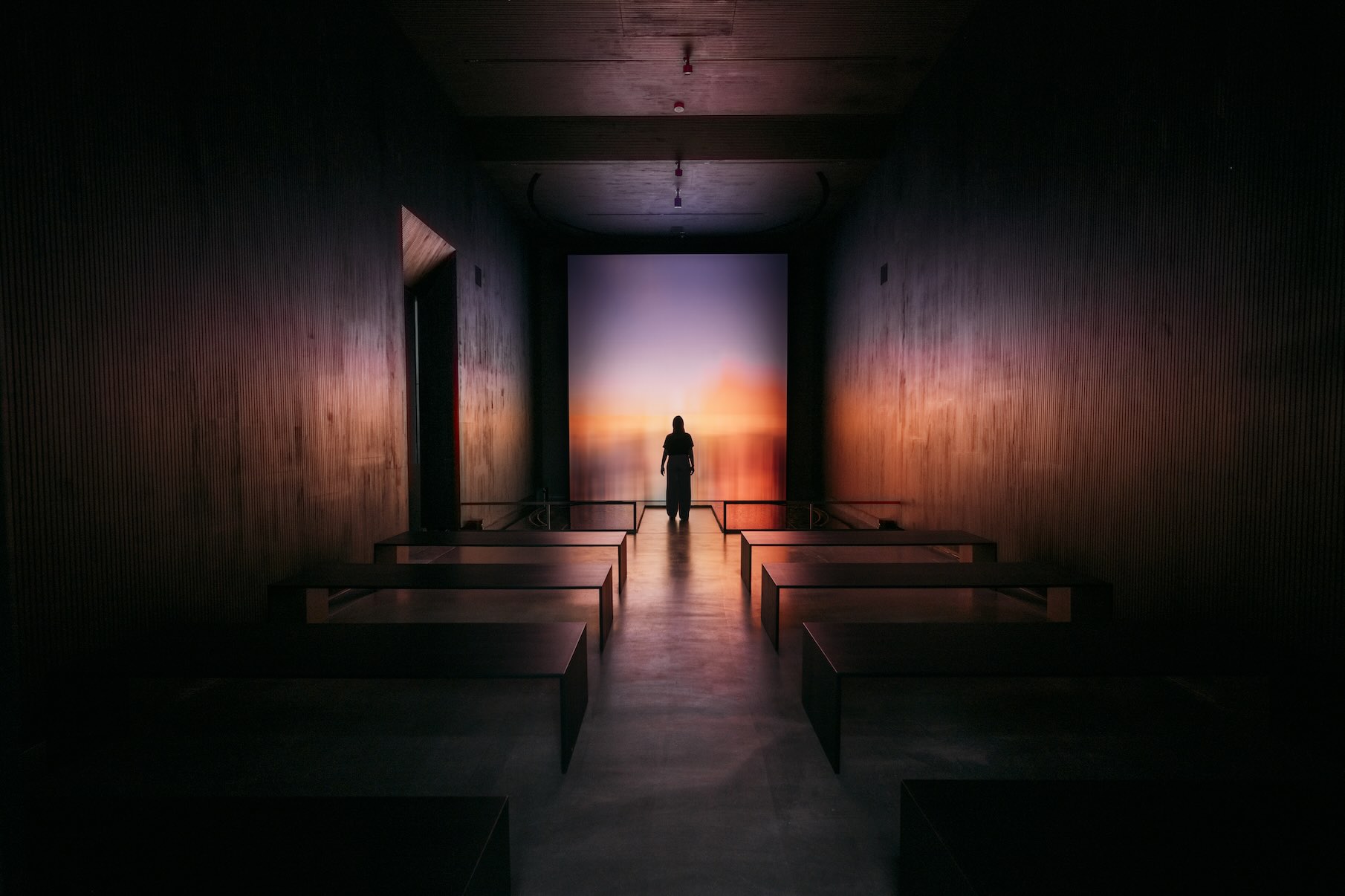
A contemporary encounter with the sublime.
In the new Gallery of Romanticism at the Pommersches Landesmuseum, visitors are welcomed by AD LUMEN, a large-scale, interactive installation conceived and designed by ART+COM Studios. The installation features a chapel-like space with two movable LED screens forming a shifting focal point — a contemporary reinterpretation of the Romanticist view of nature, immersing visitors in the landscapes around Greifswald.
As part of the installation, we composed the adaptive multichannel music that deepens its emotional and atmospheric dimension. The musical world responds to the visual rhythm and is inspired by Friedrich’s sensibility: slow-shifting harmonies, fragile textures, and wide tonal spaces that translate Romantic thought into a contemporary language.
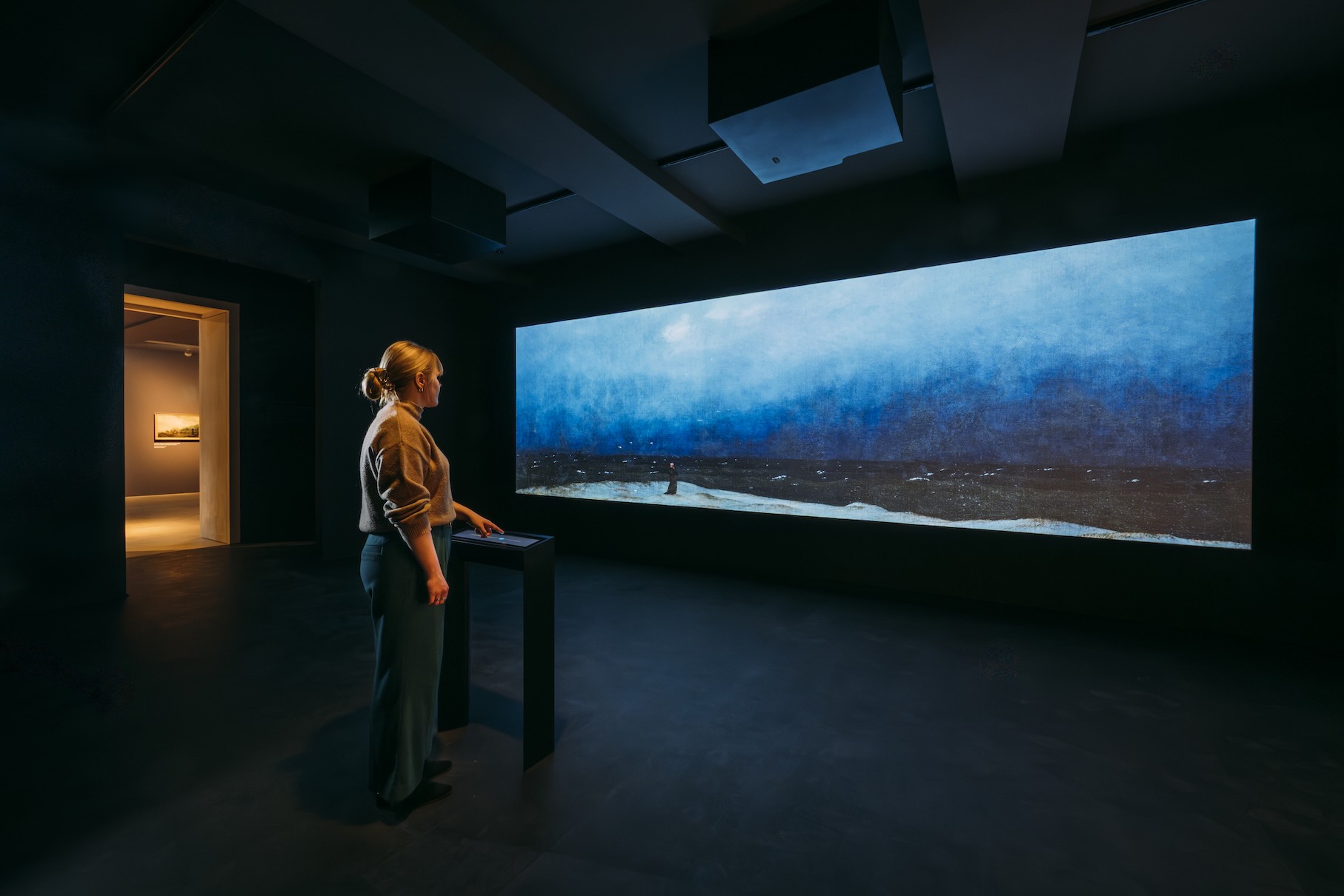
In addition to the chapel, we designed the sound for the Raum des Nordens, an interactive room within the exhibition that invites visitors to explore themes of Romanticism through their own perspectives. The sonic environment complements its exploratory character and extends the exhibition’s thematic arc.
Opened in December 2025, the Galerie der Romantik is part of the museum’s new permanent exhibition.

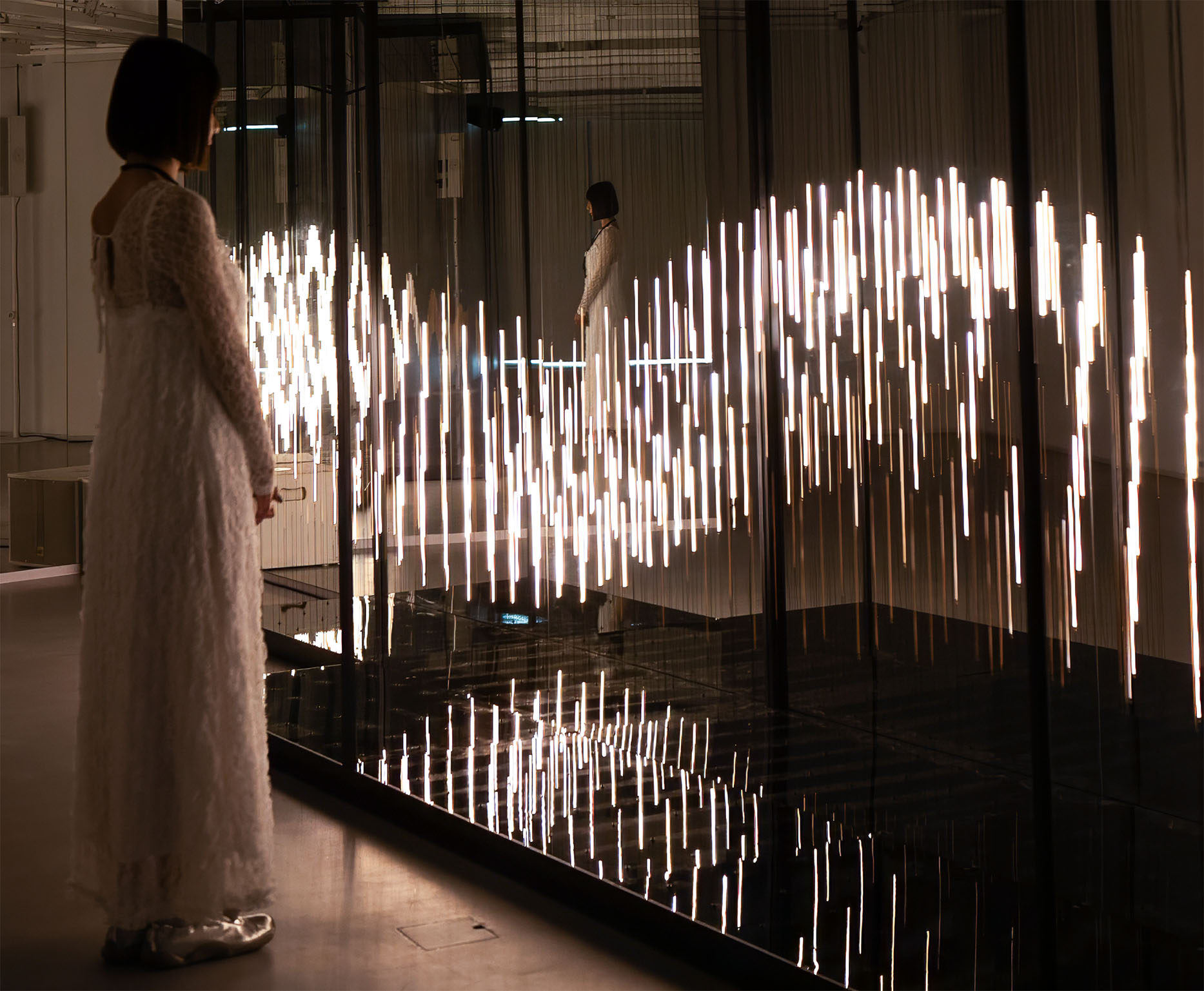
TENDER SOUL OF OCEAN: RECALL turns wind and the movement of its visitors into a responsive landscape of light and sound. Premiered at Ars Electronica 2025 in Linz and recently presented in an expanded version in Taipei, this iteration unfolds as an audiovisual organism reacting to both climate data and collective presence.
Developed together with WHYIXD, the installation integrates speculative wind-field models with real-time audience motion sensing, feeding directly into a spatial sound layer that responds to environmental input and visitor movement. Light and sound evolve as one dynamic system, dissolving the boundary between visitor and installation and turning each person into a co-creator of environmental rhythm.
The wider Tender Soul of Ocean series began in Keelung, Taiwan, where WHYIXD first translated coastal wind data into a rippling field of light in 2022. Today, Recall extends this idea across geographies and temporalities: from the winds of Keelung and the air of Venice to imagined future climates, data becomes light in motion and sound in flux. Rather than offering a fixed record, the installation reveals perception as a continuous process — a reminder that the world is a shared, fluid field shaped by human and nonhuman forces alike.


How do you define the sound of an entire exhibition?
This question marked the beginning of our work for the new permanent exhibition at Haus der Geschichte in Bonn. Across more than sixty media exhibits, including twenty-two interactives, the museum brings together a high concentration of parallel sonic sources within an open architectural setting.
To bring clarity to this complexity, we developed the signature sound: a carefully crafted sonic language shaped by criteria such as accessibility, visitor focus, noise ecology, and the acoustic character of each room. It forms the framework in which the exhibition communicates.
This sonic language extends across every layer of the experience. Modular musical tracks span both linear and interactive media. A coherent family of interface and feedback sounds guides orientation within the stations. And we supported the exhibition with consulting and mixing for all open room tones, ensuring that atmosphere and intelligibility remain in balance.
Together, these elements create an acoustic foundation that structures complexity, supports navigation, and gives contemporary German history a clear, accessible, and quietly resonant sonic identity.

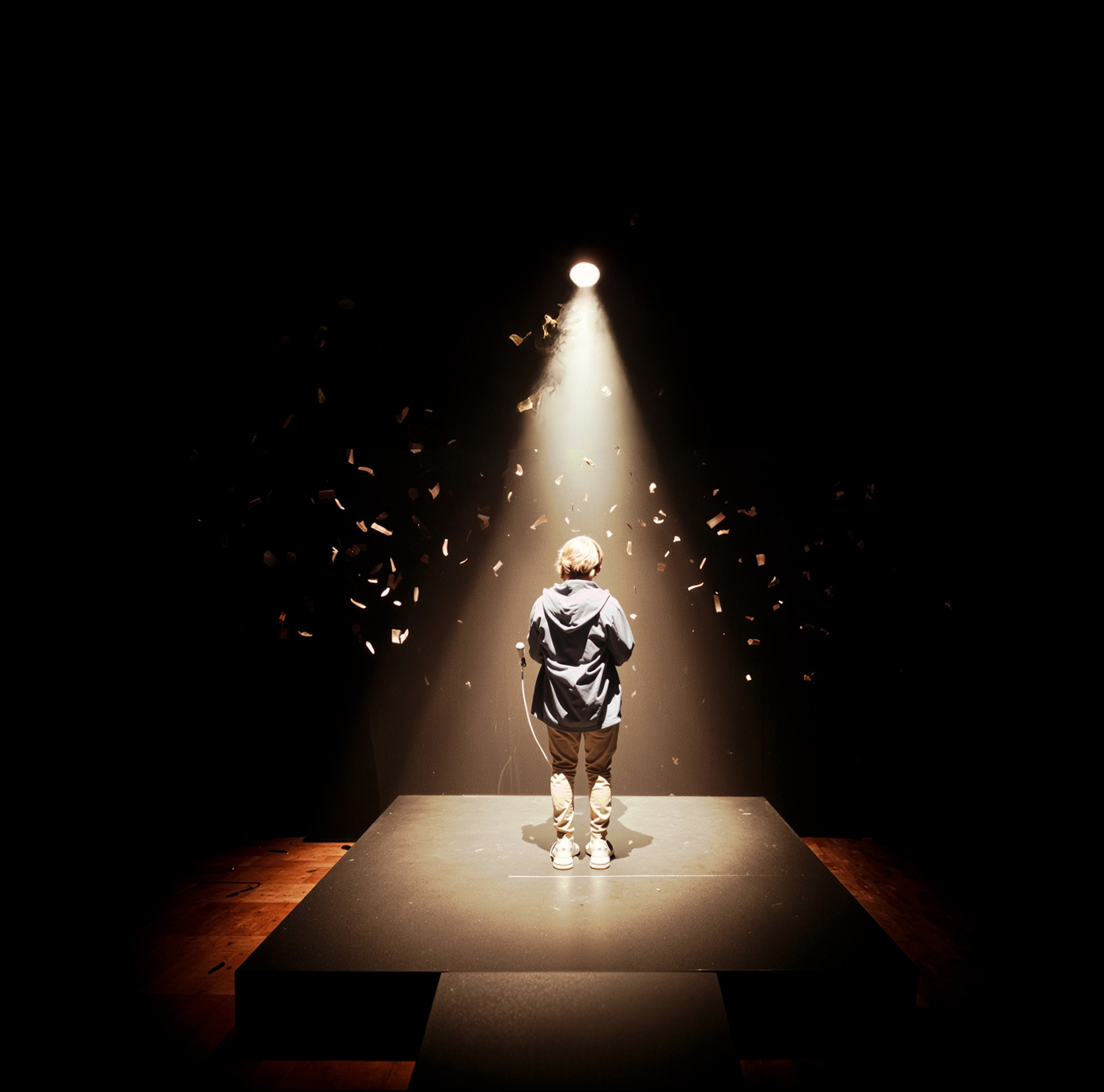
36.000 Ways transforms the technologies and aesthetics of war into an experience of presence and reflection.
Originating from Karim Ben Khelifa’s sculptural work of suspended shrapnel fragments, the installation expands into a walkable audiovisual environment. The fragments—once released by missiles capable of scattering up to 36,000 razor-sharp splinters—are frozen mid-air, suspended in the moment between impact and stillness.
In this suspended state, sound becomes the invisible continuation of their trajectory. Together with Ben Khelifa, we co-produce the work and develop the sonic and technical system that connects the visitor’s body to the installation. Using a sensor technology originally deployed by drones to detect human targets in warfare, we now use it to detect the visitor’s heartbeat. The captured pulse is translated in real time into low-frequency sound and subtle vibration through the floor.
As the heartbeat resonates through space, the fragments seem to vibrate with life again. The machinery of war turns inward, and a single human rhythm fills the room — a moment where time holds, and vulnerability becomes tangible.

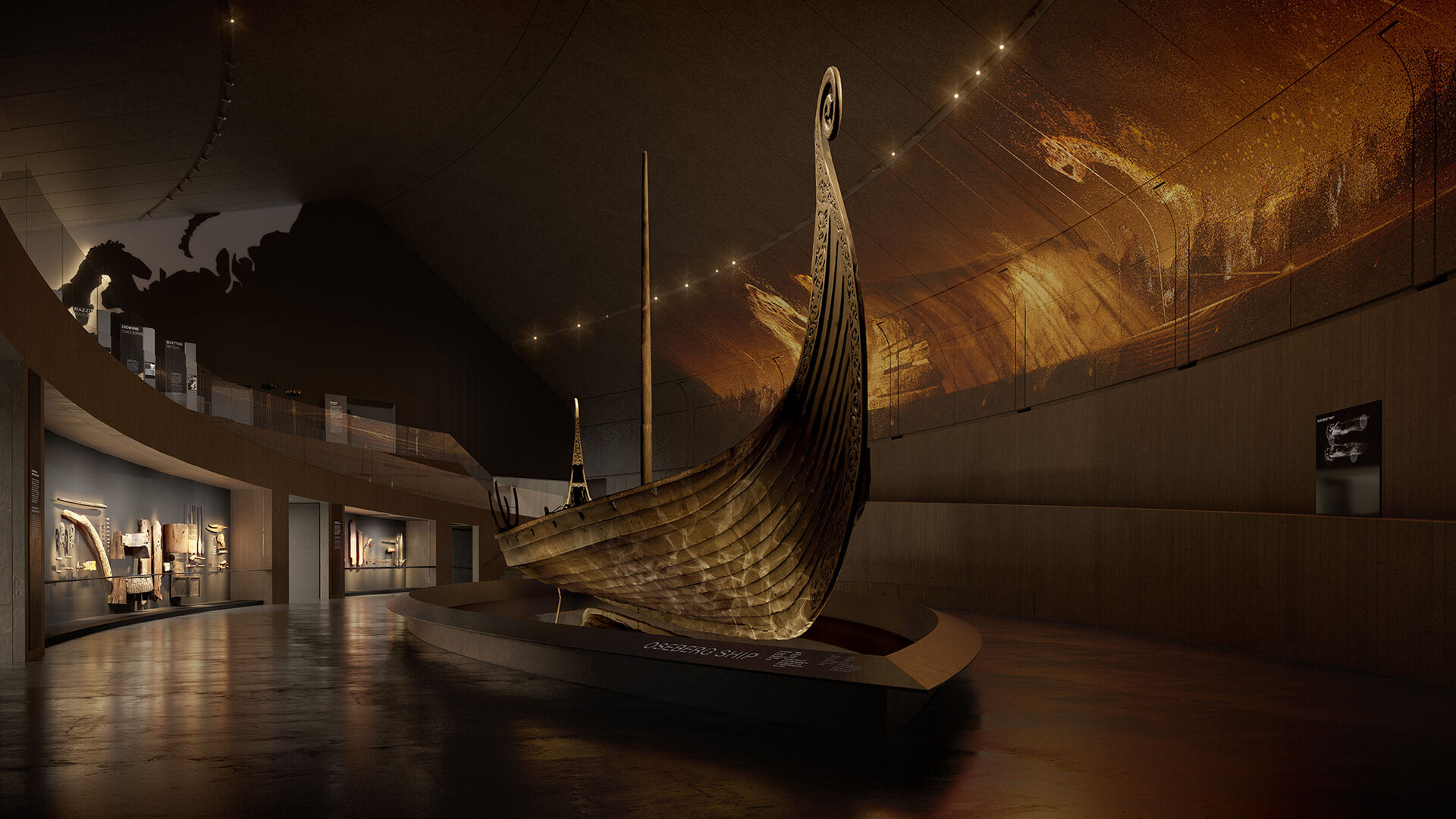
The “Kulturhistorisk Museum Oslo” is undergoing a comprehensive renewal. As part of this transformation, we are contributing the sound-experiential layer to the scenography by Ralph Applebaum Associates and TMS.

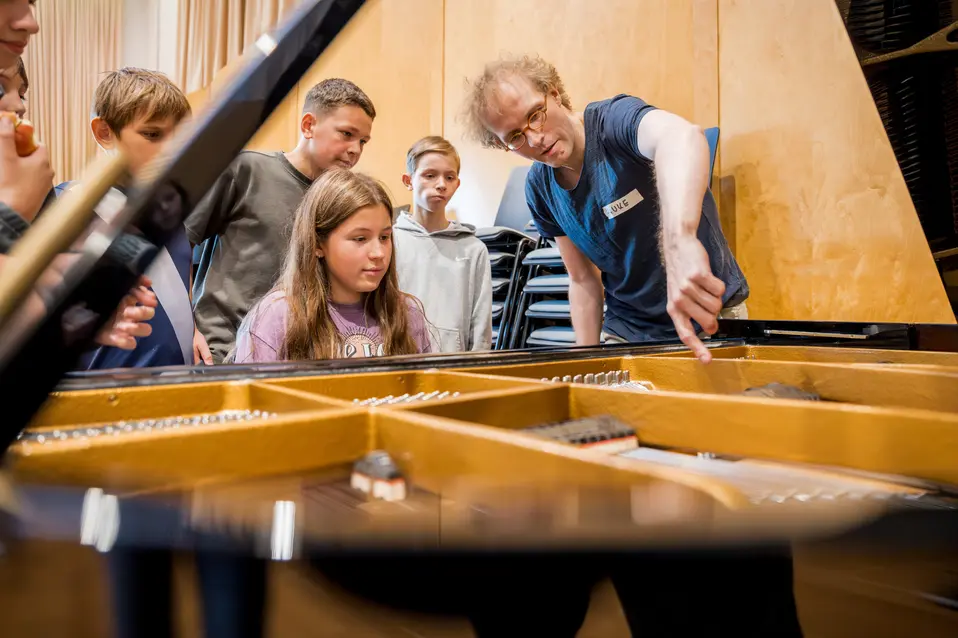
Young people create their own music theatre.
“Oper macht stark” at the Festspielhaus Baden-Baden is a cultural education programme that offers young people an experience capable of accompanying them for life. Over two years, 22 students explore opera as a space of imagination, courage, and collective creation.
For the Festspielhaus Baden-Baden and our team, this project embodies the essence of meaningful creative work. It shows how young people can experience self-efficacy, expand their horizons, and engage in a democratic, participatory process of making art together. It opens a door to the inner world and creates a shared journey where boundaries become playful, horizons expand, and new perspectives emerge.
To support this journey, we guide the project and design technological setups for the composition process that give the students full access to their creativity. These intuitive tools allow them to shape melodies, rhythms, and structures directly from their own impulses — making composition an immediate, accessible, and empowering experience.
Together with students from the Hochschule für Musik Karlsruhe and musicians of the SWR Symphonieorchester, the group develops an original music theatre work that will premiere at Festspielhaus Baden-Baden on the 6th of May 2027 at 18 Uhr.


We are excited that Dark Rooms premieres at Venice Immersive – 82nd Venice International Film Festival, where the work opens its world to audiences for the first time.
The VR documentary guides participants through four personal narratives of sexuality, self-discovery, and connection. Stories told by the people who lived them, co-created with the filmmakers in an atmosphere of trust, presence, and mutual authorship.
We composed a modular musical score that moves with the film through its four chapters, shaping the emotional atmosphere of each room while preserving the work’s cinematic flow.
Each chapter forms a sensorially distinct environment shaped by desire, culture, and imagination. Within this shared VR space, three participants enter together; what begins as observation becomes embodied presence. Identity is felt rather than explained. Vulnerability becomes a common ground.


A Data-Driven Requiem.
In collaboration with Miiqo Studios, we developed Sounds of the Unseen—our artistic contribution to THE HERDS, a public art project that traces a 20,000 km journey from the Congo Basin to the Arctic Circle.
To accompany this epic migration, we created a generative soundscape that draws on over 6.5 billion animal movement data points, provided by Movebank and the Max Planck Institute of Animal Behavior. Shaped by real-time weather and local ecology, the soundscape evolves continuously. It gives voice to endangered and extinct species, creating a sonic memory of biodiversity on the move.
It’s more than an ambient score—it’s a living composition, a data-driven requiem, and an invitation to tune in to the more-than-human world.
Special thanks to the Max Planck Institute of Animal Behavior for granting access to this remarkable dataset.

HOW WE CREATED SOUNDS OF THE UNSEEN
SOUNDS OF THE UNSEEN is guided by real movement data from animals on epic journeys—birds crossing continents, whales navigating oceans, land mammals roaming vast terrains. Rather than following individuals, we hear an entire ecosystem in motion. Each sonic layer reveals a different part of the story.
Behind the scenes, a custom-built sound engine interprets each data point in real time, translating patterns of movement into musical gestures. Instead of fixed melodies, it produces evolving textures—shaped by movement data, local conditions, and the rhythm of the seasons.
At the foundation lies a deep, continuous drone—like the Earth’s heartbeat—shaped by the activity of land-dwelling species. The more movement is detected, the more the harmonies shift and evolve.
Above this base, higher-pitched tones respond to animals in the air, while a third, fluid voice traces movements in the sea. Here, pitch glides reflect the distance traveled since the last signal—longer journeys stretch the tone, shorter ones keep it close and tight.
Every GPS ping—every sign of life—nudges the composition forward, subtly altering mood, pitch, and texture. The soundscape mirrors not only individual movement but also the larger, cyclical rhythm of seasonal migration. These patterns form the dramaturgical backbone of the piece, dividing the composition into four chapters, each representing a season. Each chapter carries its own chord progressions and tonal center, reflecting the shifting emotional and environmental conditions that accompany migration across the year.
For the composition, we worked with a cleaned and curated dataset of around 2 million animal movement points, representing a full year of migrations across land, sea, and air. This data is sonified in real time over a three-day journey, with seasons unfolding in fast-forward. After three days, the cycle begins anew—yet the piece never repeats itself. The engine processes each moment live, so the composition remains fluid, nuanced, and always slightly different.
As the piece travels along an imagined path from the Congo Basin to the Arctic Circle, it adapts to its virtual surroundings. The calls of animals over tropical forests sound different from those in polar landscapes. The system reacts to changes in species, direction, and even weather. You might hear rising wind, distant rain, or sudden stillness.
Like the animals it follows, the soundscape is never fixed. It is responsive, ephemeral, and deeply attuned to the living rhythms of the planet. SOUNDS OF THE UNSEEN forms a sonic memory of migration—a requiem for vanishing patterns, and an invitation to tune in to the more-than-human world.
PHOTO CREDITS
1) Kinshasa - Congo Basin (c) Berclaire for The Walk Productions // 2) Manchester City Centre (c) David Levene // 3) Medina. Marrakesh, Morocco. (c) Oussama Oulhiq // 4) HM King Charles meets THE HERDS at Lancaster House (c) Jaber Ahmed (DEFRA) // 5) Makoko River, Lagos. Photograph by Kashope Faje, for 88 Life Studios // 6) Venice, Italy. Photography by Andrea Avezzù. Courtesy of La Biennale di Venezia // 7) Paris, France. Photography by David Levene

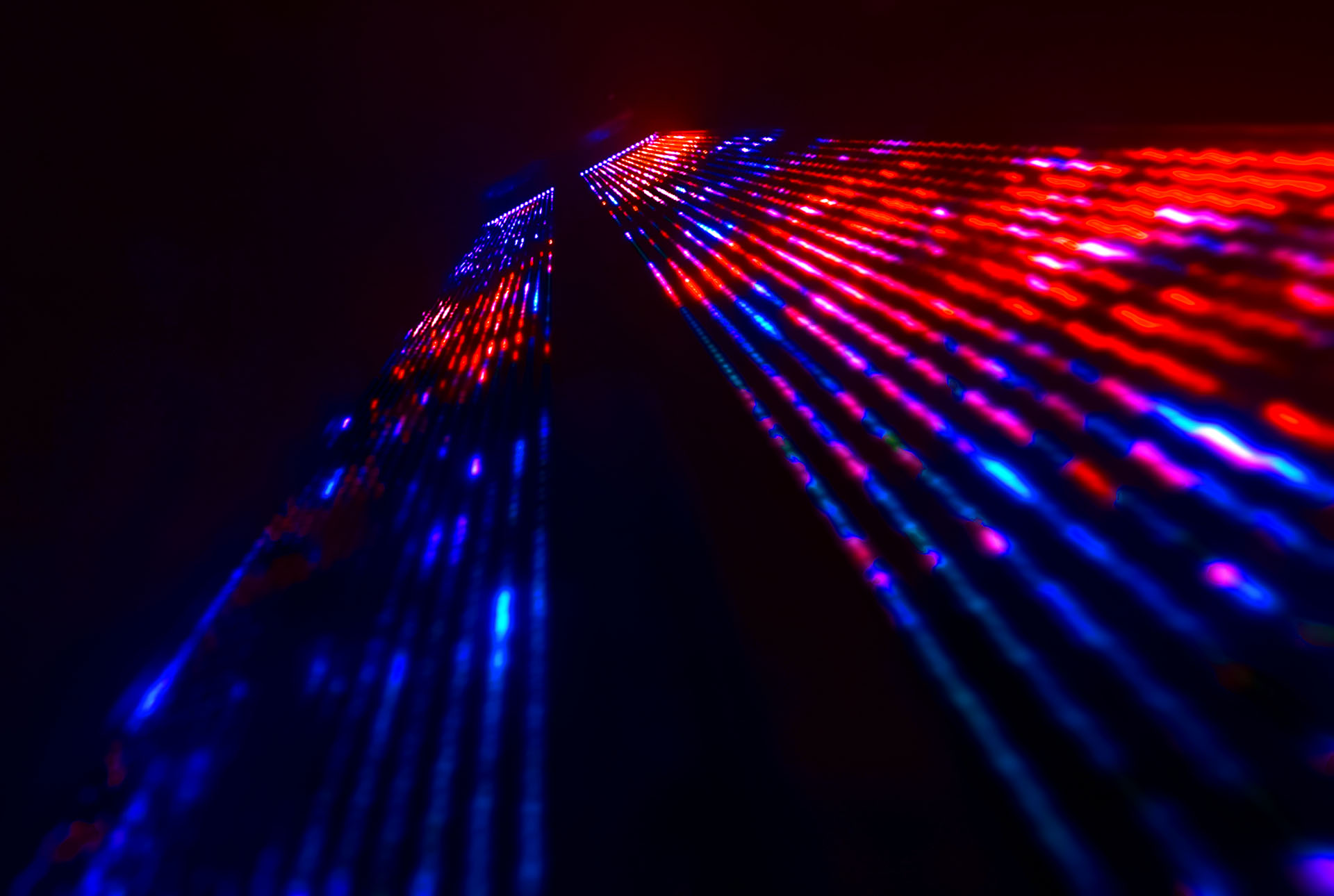
Which emotions lie behind political speeches?
Throughout history, spoken words have moved our emotions. Despite today’s technological advances, they remain just as powerful—now amplified by the mass media. Words do more than share information; they shape how we see the world, reinforce beliefs, and influence our emotions.
Nowhere is this more evident than in political speeches. These are not just statements of policy but carefully crafted narratives designed to resonate on a deep emotional level. A political speech is an attempt to construct a shared worldview, to define what is true, what is urgent, and what must be done. It is language at its most persuasive, applied at the highest level of influence.
BEHIND THE WORDS translates the emotional layer of political rhetoric—from across the spectrum—into an immersive audiovisual experience, allowing visitors to explore the power of language beyond the words themselves.
EXPLORE THE AI-ANALYSED SPEECHES
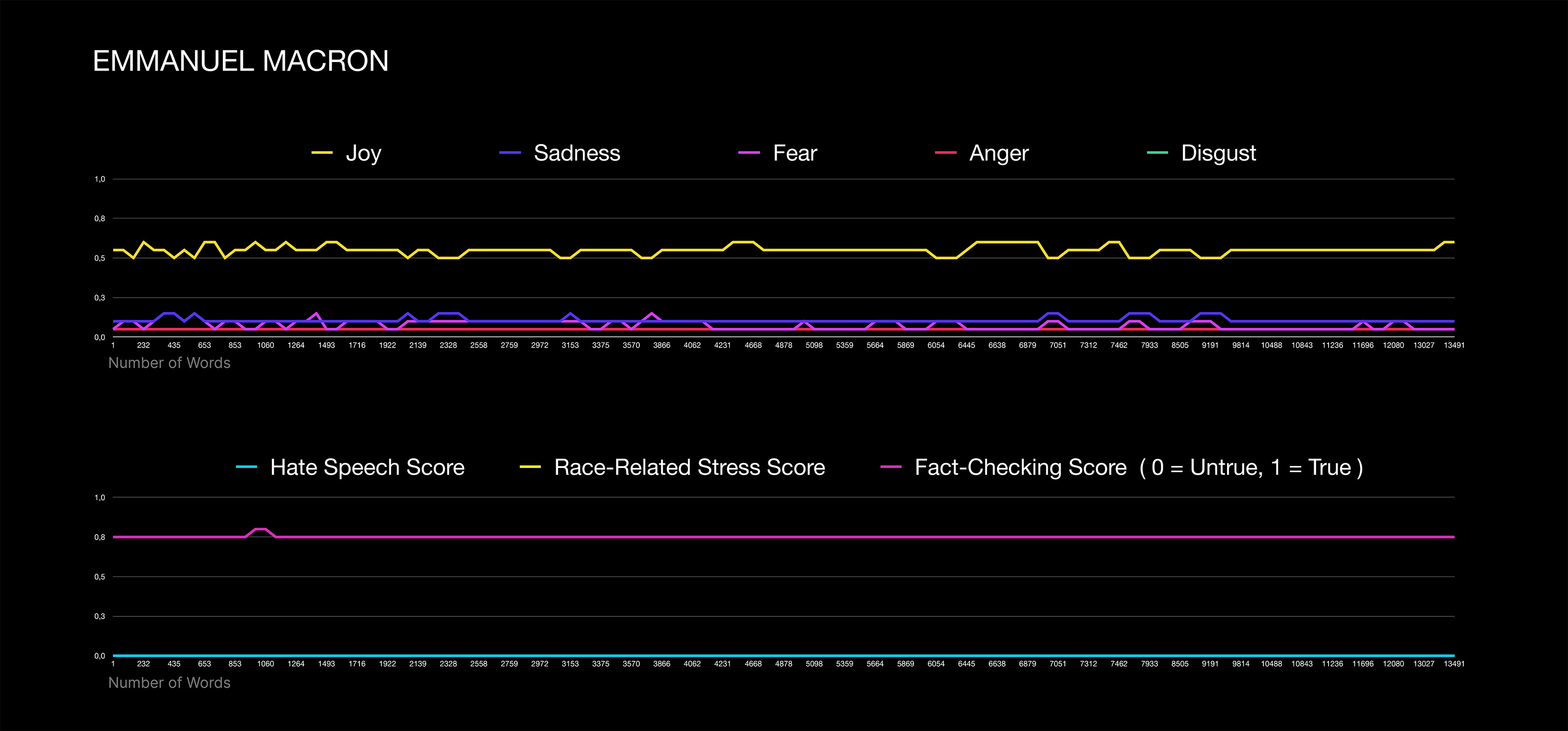
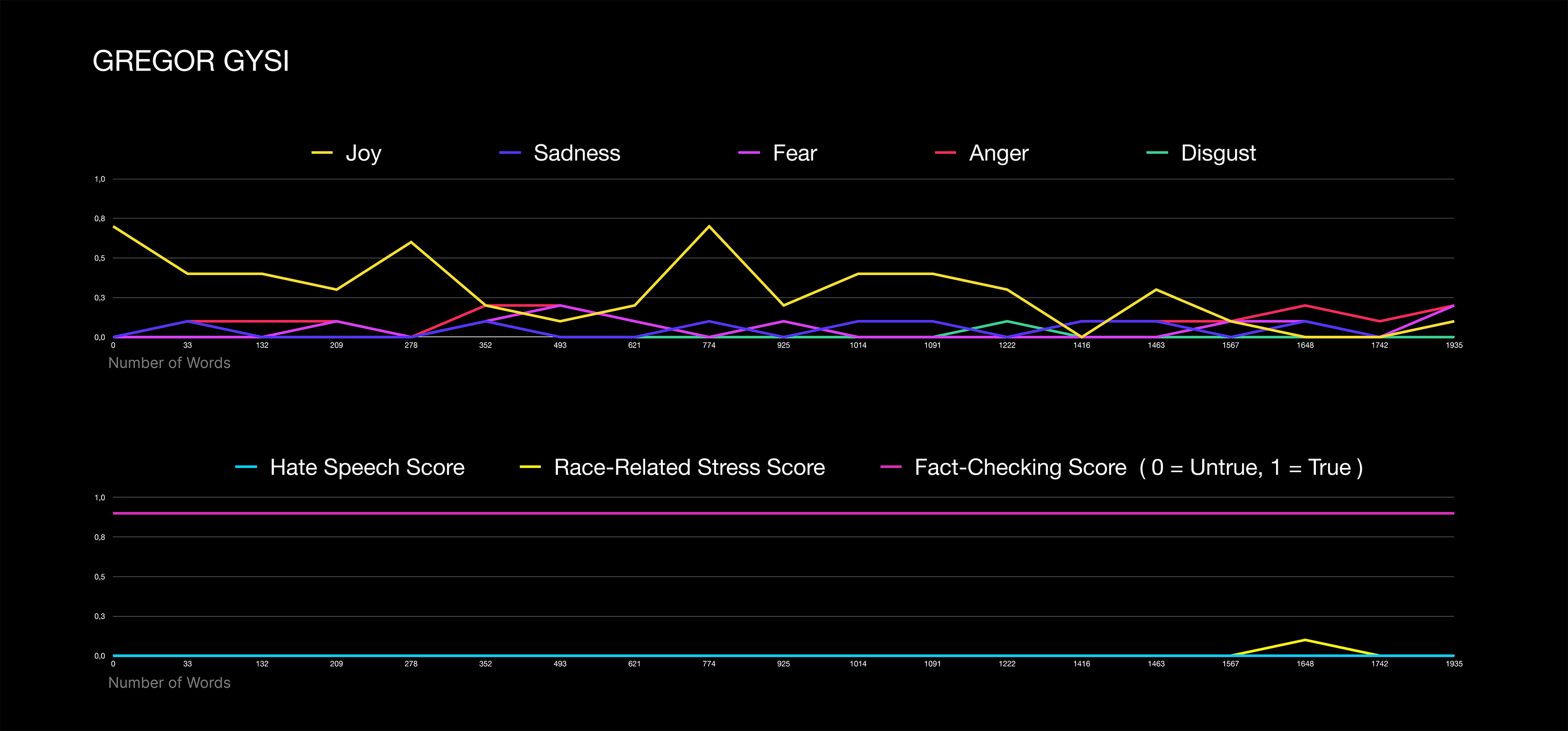
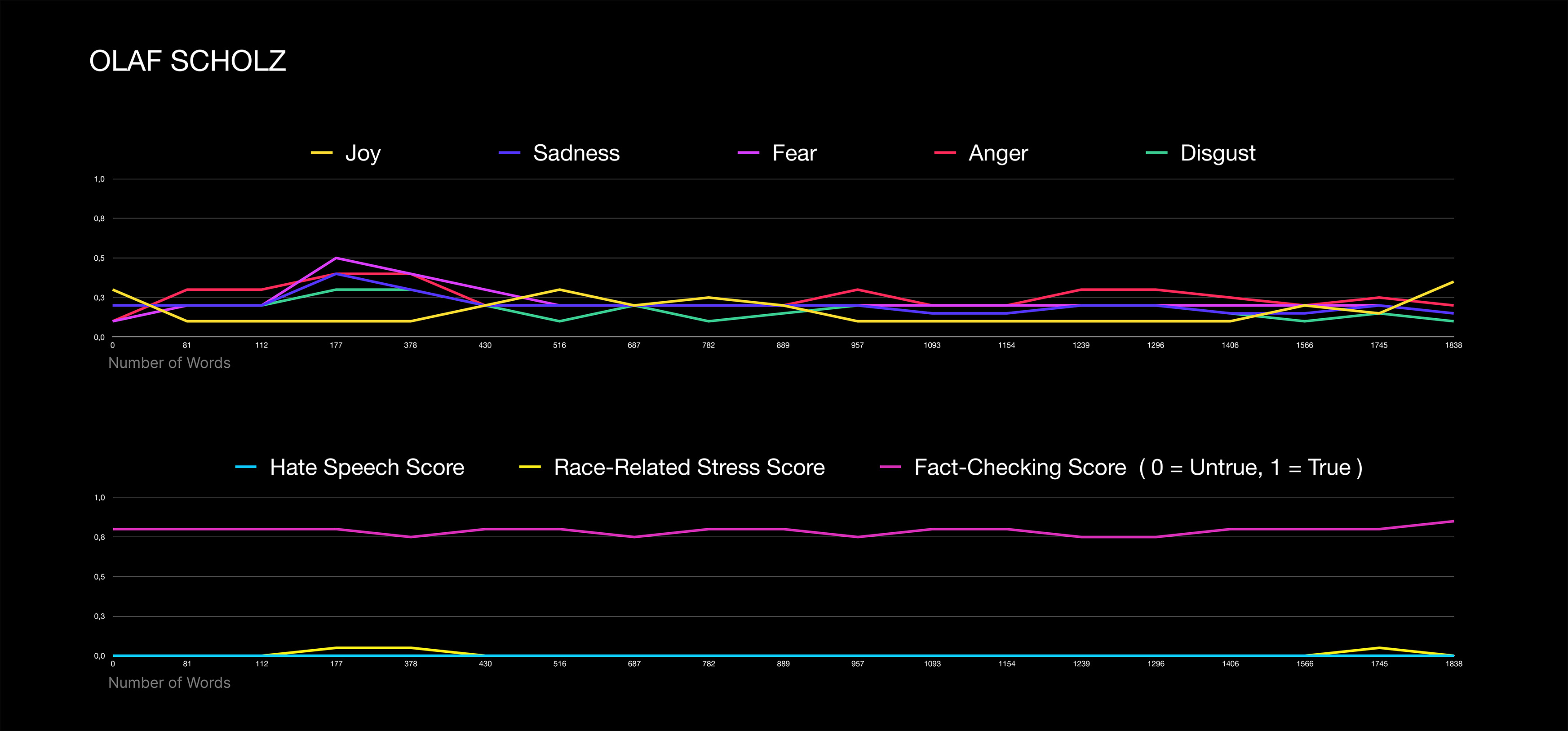
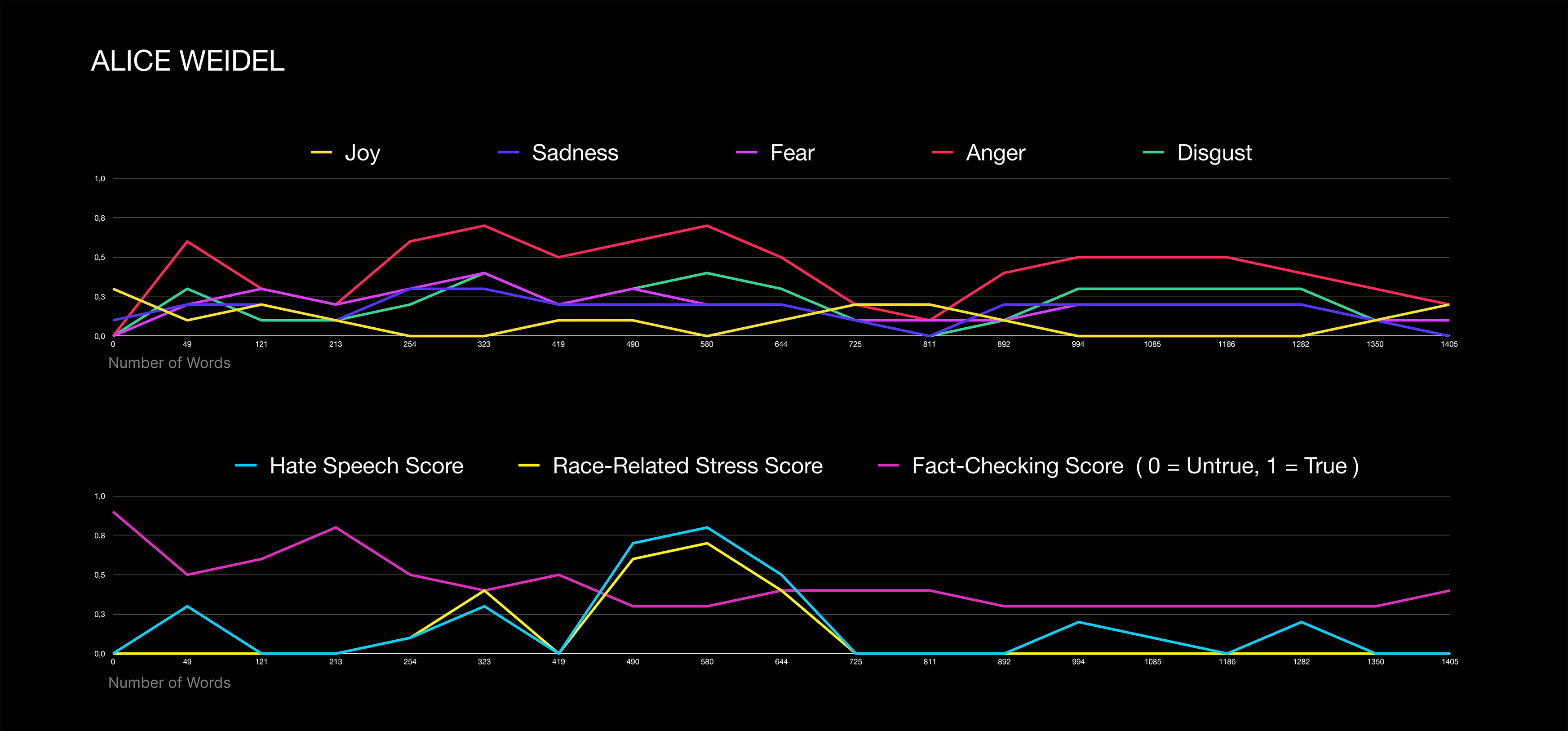
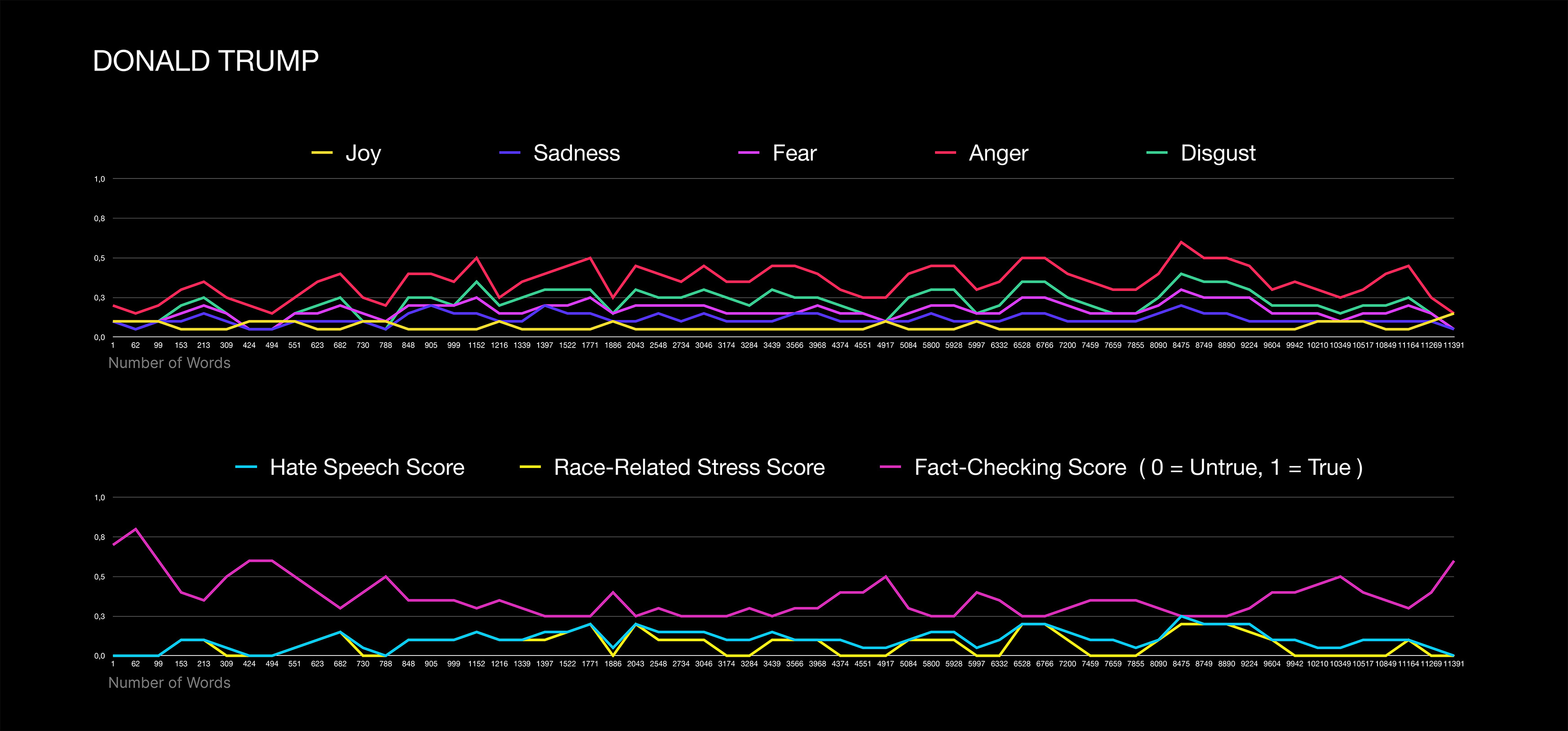
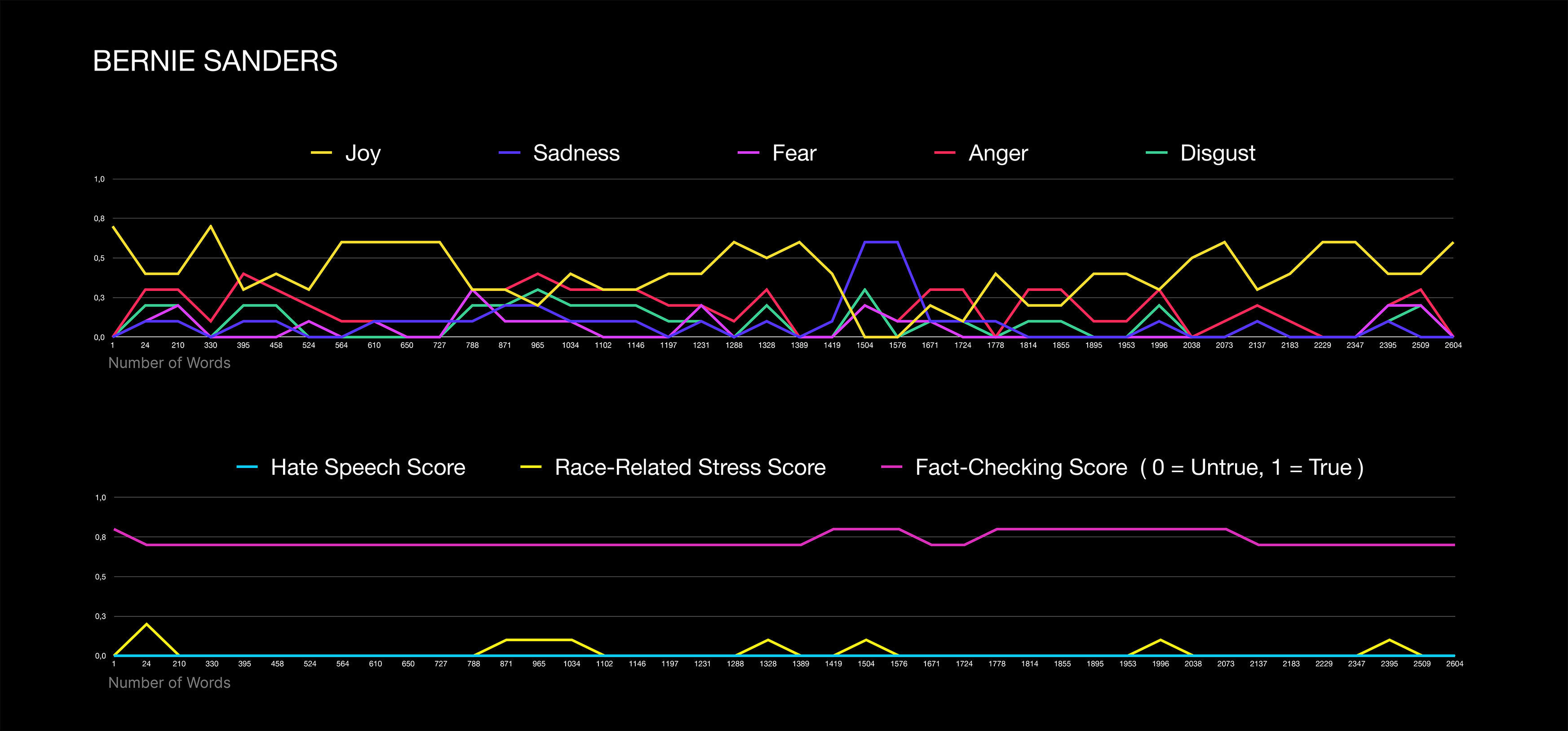
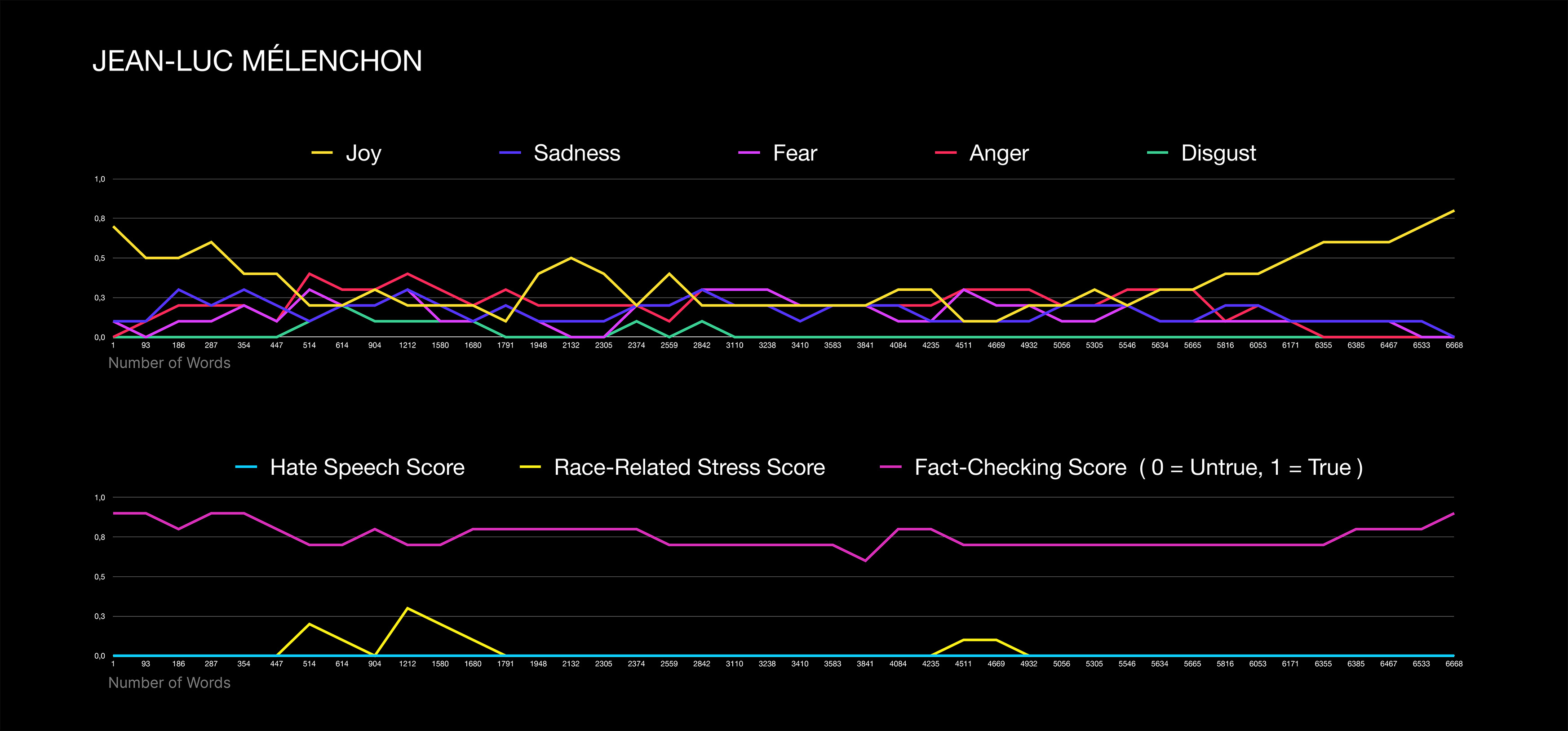
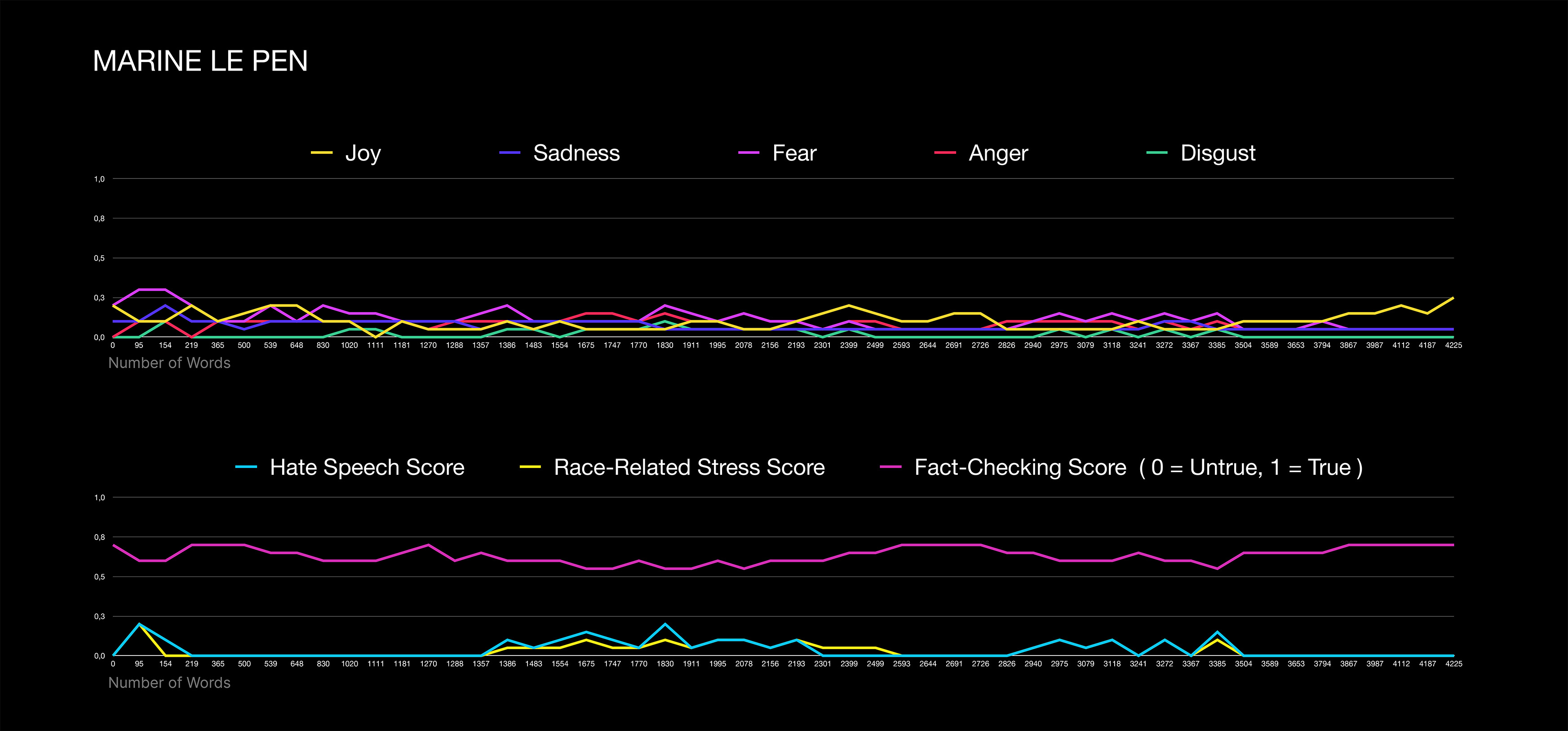
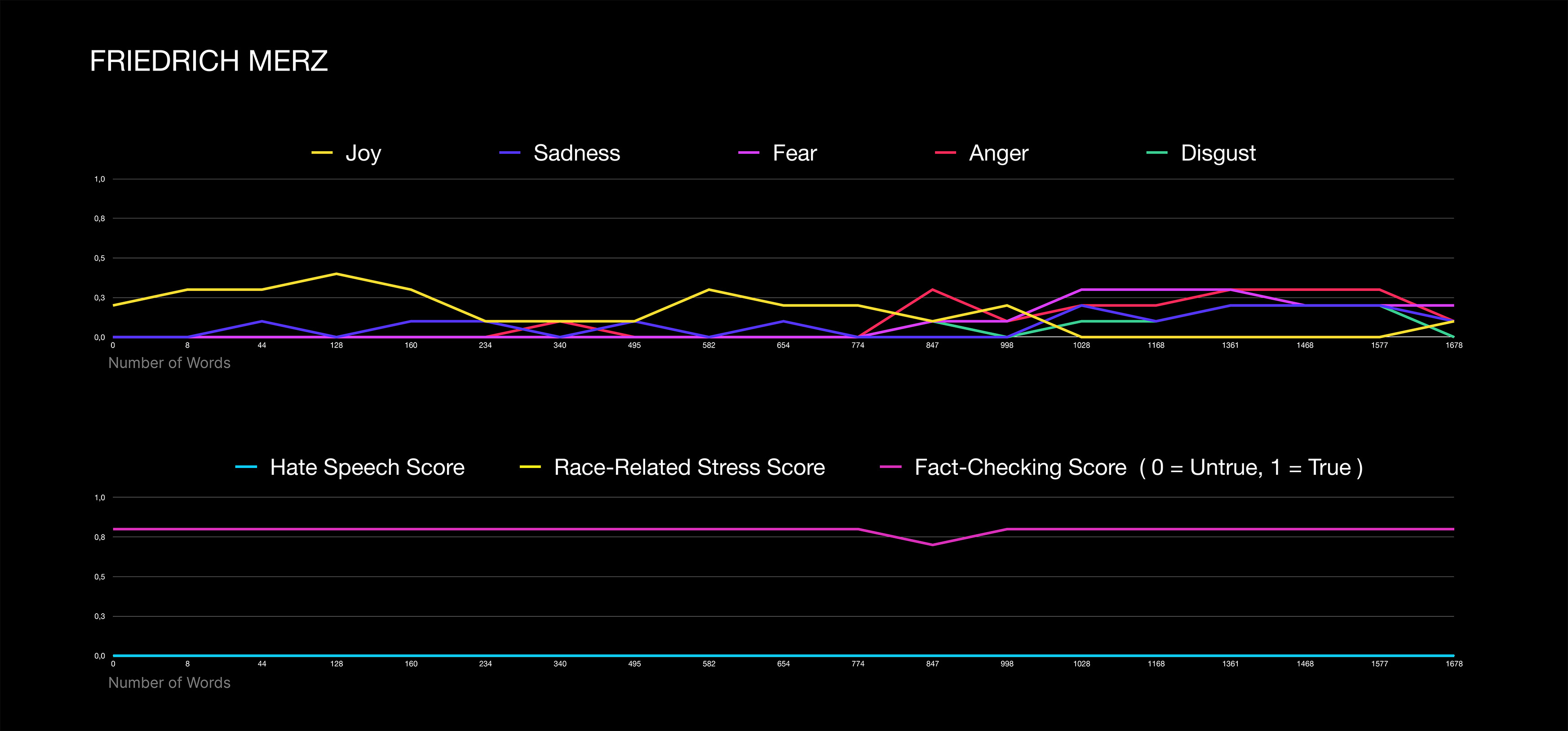
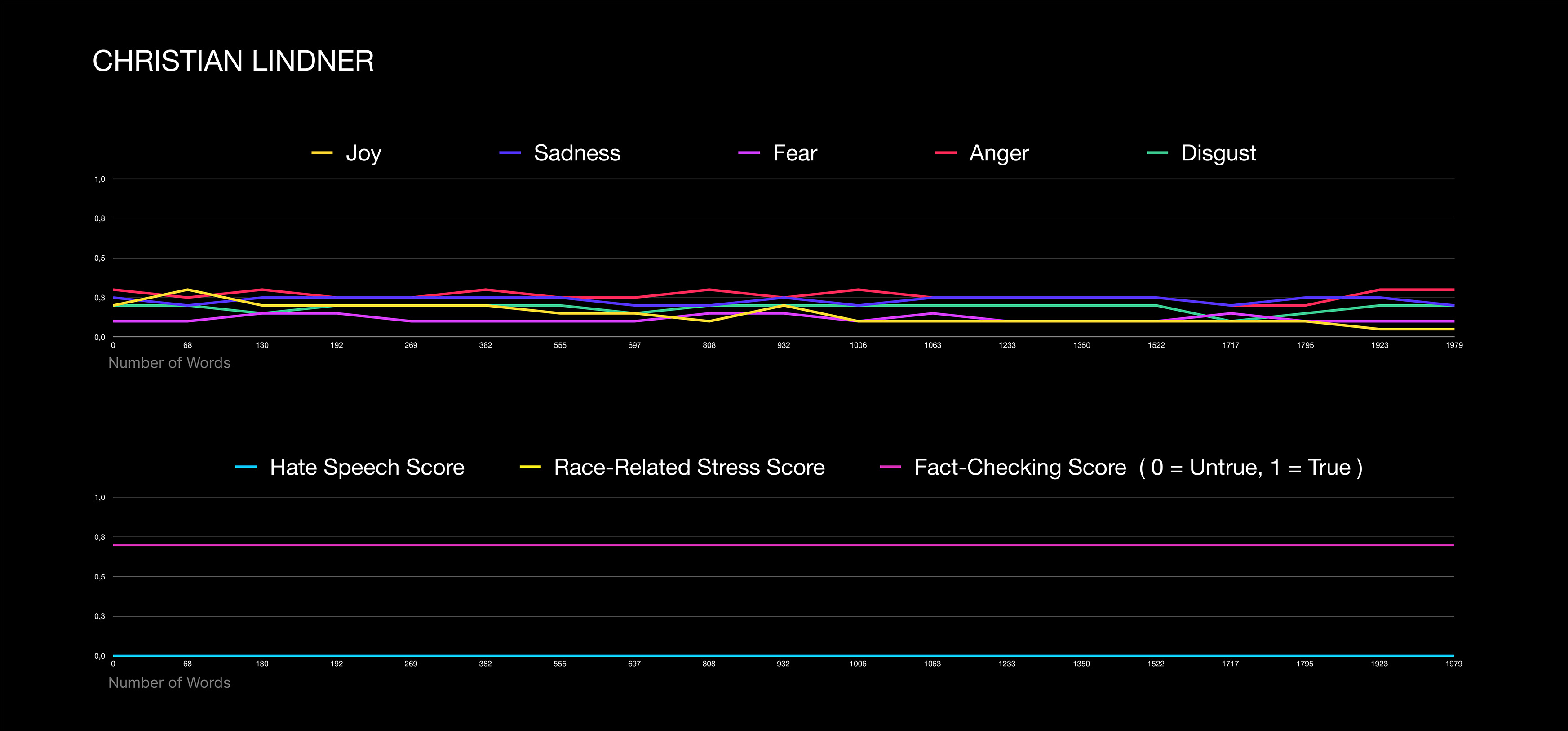
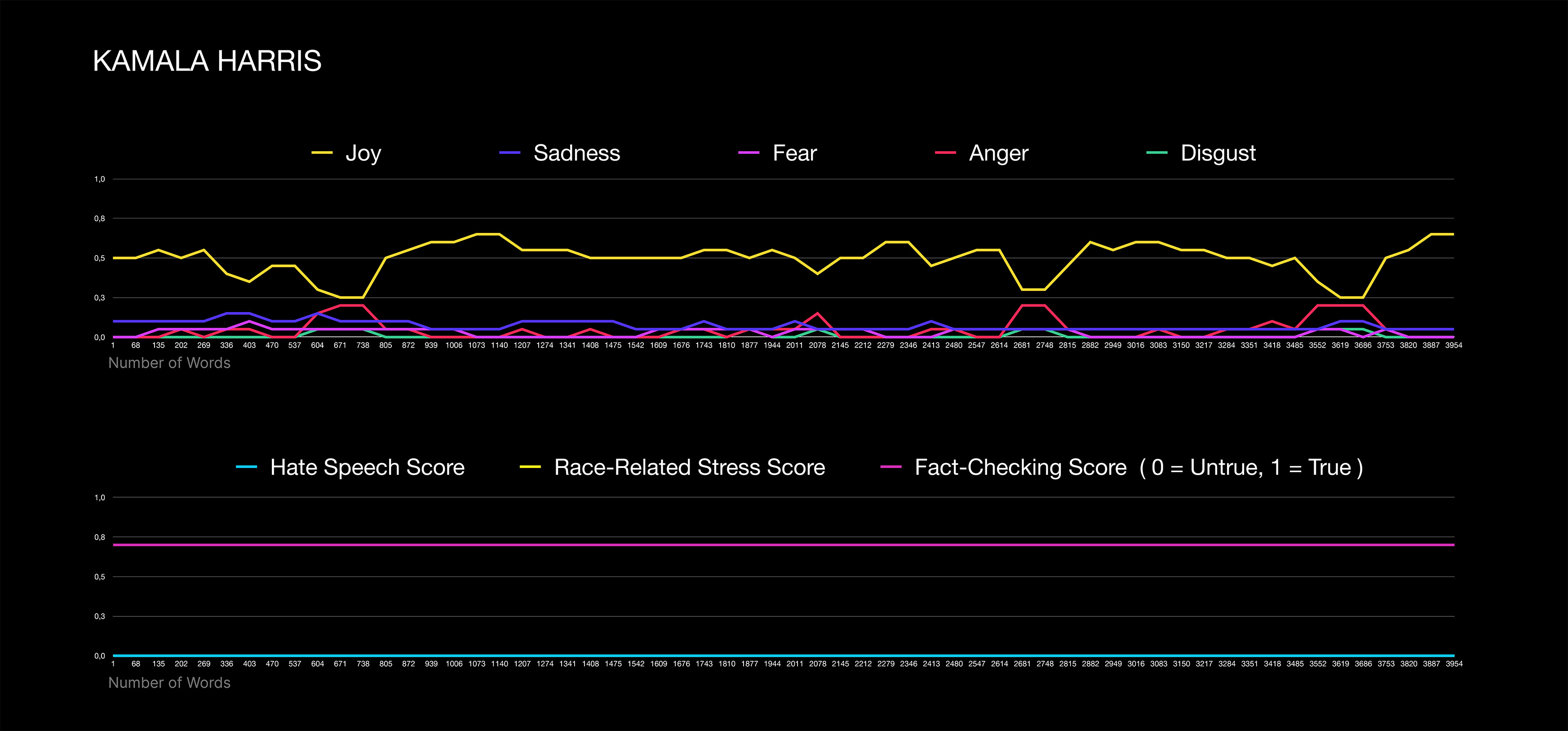
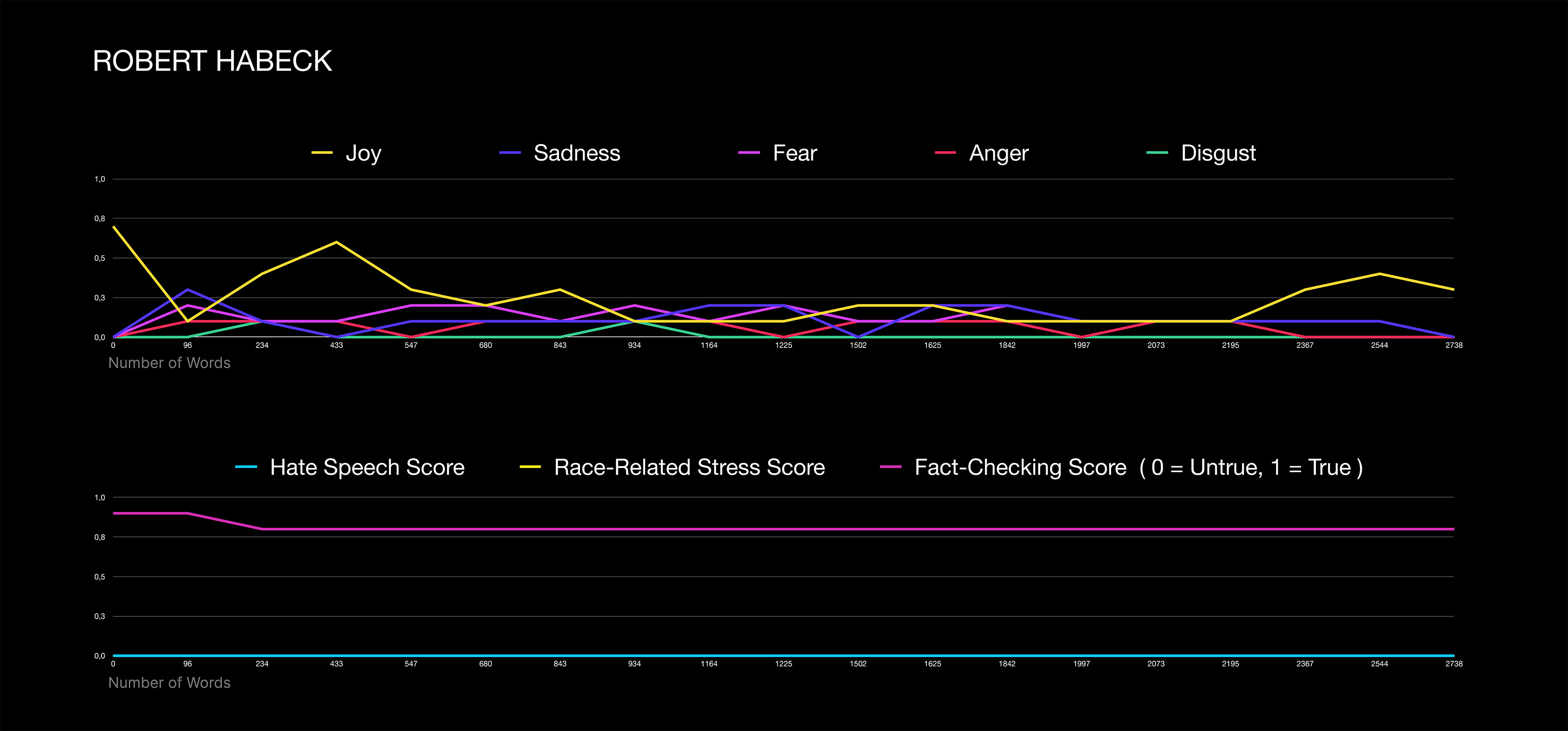
Find out more about our method: Project Site
Focusing on the last five years of presidential campaign speeches in the Western Hemisphere, the installation presents the political spectrum in three distinct rooms—left, center, and right. Each room immerses visitors in the emotional landscapes that define these social spheres, revealing the persuasive power of language.
To do so, the installation draws on an AI-driven analysis of sentiment and five key emotions—joy, anger, sadness, disgust, and fear—alongside indicators such as hate speech, race-related stress, truth benchmarks, and automated fact-checking.
The data output is then translated into a musical and visual score, allowing visitors to both hear and see how the speech unfolds paragraph by paragraph. Rather than passing judgment, the installation invites reflection—showing how easily emotions can overshadow facts and prompting us to question when persuasion crosses the line into manipulation.
Through shifting light and sound, visitors physically experience the emotional contours of each speech. This sensory immersion highlights the unseen forces that influence our political realities. Only by recognizing the role of emotions in shaping our views can we begin to look beyond them.
BEHIND THE WORDS premiered in 2025 at Dark Rooms Hotel


Turning Brain Activity Into Music.
GEFÜHLSRAUSCHEN, a collaboration between Studio TISH (Yves Peitzner) and KLING KLANG KLONG, is an interactive installation that transforms neural activity into a shared experience of sound and light. Using EEG sensors, the system interprets brainwave patterns associated with emotional states and translates them in real time into a continuously evolving musical composition and responsive lighting.
Up to three visitors sit in a circular setting, each connected to a sensor system that detects their neural activity. These signals are mapped to musical motifs distributed across three instruments: piano, bass, and strings. Emotional states such as joy may generate bright, lyrical phrases; melancholy leads to sparse and fragile textures; discomfort introduces low, tense, dissonant layers. As the neural patterns shift and converge, the composition reshapes itself — not into one dominant mood, but into a complex, collective emotional expression.
What unfolds is a living musical dialogue that evolves with the presence, perception, and emotional interplay of those within it.
EXCERPT 1
EXCERPT 2
The piece premiered at the opening of Nürnberg Digital Festival NUEDIGITAL 2025


Virtual Tour Through The Austrian Pavilion.
Since spring 2025, the Austrian Pavilion at Expo in Osaka has welcomed international visitors into a multisensory experience shaped by architecture, narrative – and sound.
For Composing the Future, we created an immersive sound scenography that guides visitors on a musical* journey from Austria’s classical heritage to contemporary innovation. The spatial sound layers move fluidly with the exhibition, shaping atmosphere, dramaturgy, and emotion.
A glimpse of this experience is now available online:


Supporting Emerging Artists.
This year at the Lost Art Festival in Berlin, the CX Collective premieres its first collaborative work: CHAMAECHORIE – an immersive installation featuring artificial tumbleweeds, laser-defined borders, and shifting air currents. The piece explores the delicate tension between movement and restriction, drawing poetic connections between natural forces and human-made boundaries.
The CX Collective was formed by five students from Film University Babelsberg KONRAD WOLF through the interdisciplinary course “CX Project,” hosted by the university’s Creative Exchange Studio. Throughout the process, KLING KLANG KLONG supported the team with conceptual and technical mentorship – helping shape the experience from early sketches to immersive execution.
Our involvement is part of our ongoing commitment to supporting emerging artists through academic collaborations – as we do, for example, with students from HDM.
We’re proud to accompany new voices on their creative journeys and look forward to seeing Chamaechorie come to life at Lost Art Festival.
Sign up for our newsletter!